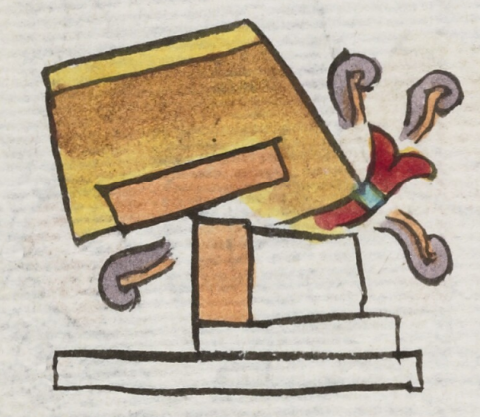tepehualiztli (Mdz13v)
This iconographic example shows a defeat (implied in the burning of a town's temple), or what might be called tepehualiztli. It combines the elements of a building (teocalli) on fire and the roof tipping over. Smoke (poctli), colored purple and terracotta or orante, pours out (popoca, smokes), and a red flame (tletl) with a turquoise band at the middle also emerges from the tipping roof. The roof is yellow and brown, as though it might be thatch. There are also two terracotta-colored beams, one vertical and one horizontal at the building's entrance. The building is from a side view. The foundations of the buuilding are white. This image repeats many times across many pages in the Codex Mendoza. We have only captured this one example, owing to all the repetition.
Stephanie Wood
The visual elements in this compound glyph do not enter into the phonetic reading of the glyph. It is an ideogram. Alternate readings include tepehua (to defeat) and its root, pehua (to attack, when in a war context), or popoloa (to erase, abolish, or destroy through battle). The suggestion that it might be a teocalli (religious temple) comes from another glyph so identified in this collection that appears to have a thatched roof (below). But see also the teocalli in the place name Teocalhueiacan (below), which is a burning temple, suggesting it was attacked and possibly brought under imperial hegemony. We have selected the term for labeling this action based on the term used by Alonso de Molina (in our Online Nahuatl Dictionary), because it is not glossed.
Stephanie Wood
c. 1541, but by 1553 at the latest
Stephanie Wood

tepehualiz(tli), a defeat, https://nahuatl.wired-humanities.org/content/tepehualiztli
tepehua, to defeat, https://nahuatl.wired-humanities.org/content/tepehua
pehua, to attack (when used in a war context), https://nahuatl.wired-humanities.org/content/pehua
popoloa, to destroy in battle, https://nahuatl.wired-humanities.org/content/popoloa
Stephanie Wood
Codex Mendoza, folio 13 verso, https://digital.bodleian.ox.ac.uk/objects/2fea788e-2aa2-4f08-b6d9-648c00..., image 37 of 188.
The Bodleian Libraries, University of Oxford, hold the original manuscript, the MS. Arch. Selden. A. 1. This image is published here under the UK Creative Commons, “Attribution-NonCommercial-ShareAlike 3.0 License” (CC-BY-NC-SA 3.0).


